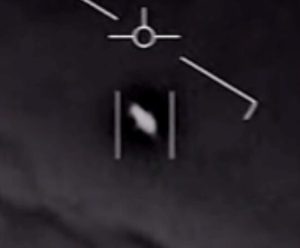Joanna York* considers an updated report on unidentified flying object (UFO) sightings delivered to the United States Congress.
 The United States Office of the Director of National Intelligence (ODNI) has provided an update on a 2021 report which investigated 144 unexplained sightings between 2004 and 2021 by US Government sources, including military personnel.
The United States Office of the Director of National Intelligence (ODNI) has provided an update on a 2021 report which investigated 144 unexplained sightings between 2004 and 2021 by US Government sources, including military personnel.
If the 2021 report marked a shift in attitude towards what are officially called Unexplained Aerial Phenomena (UAP), discussions since then have gathered pace.
The updated report is the first in a series of annual dossiers promised by the ODNI through to 2026.
At a Congressional hearing earlier in the year — the first on UAP since major Government investigations stopped in 1969 — Pentagon officials said the number of incidents under investigation had risen to more than 400.
In July, Harvard University marked the one-year anniversary of its Galileo Project, aiming to transform the search for extra-terrestrial life “from accidental or anecdotal observations and legends to the mainstream of transparent, validated and systematic scientific research”.
In October, NASA began its own independent study into “observations of events in the sky that cannot be identified as aircraft or as known natural phenomena”.
It says this study will lay the groundwork for future investigations by identifying how unclassified data gathered by civilians, organisations, the Government and other sources can be analysed “to shed light on UAPs”.
The search for answers in the Cosmos seems to have begun in earnest.
Director of the Jodrell Bank Centre for Astrophysics, Michael A. Garrett says if there’s something interesting out there “I think we’ll know pretty soon”.
He believes there is the possibility of real scientific discovery.
Renewed interest in UAPs was sparked by a series of high-profile sightings by US military personnel.
Among one of the most discussed is an encounter with a “tic-tac shaped” object.
Retired US Navy Lieutenant Commander, Alex Dietrich was one of a crew who spotted the object during a military training mission in 2001.
“It looked like a little breath mint in larger-scale; white, oblong, no apparent flight-control surfaces, no apparent physical means of propulsion,” she told news outlets at the time.
“It was moving in a way that we didn’t recognise and couldn’t classify.”
Explanations have never been forthcoming. In the ODNI’s 2021 report, analysts were able to explain just one out of 144 reported UAP sightings, which was found to be a large, deflated balloon.
In the 2022 update, half of a total 366 cases remain unexplained. Those that can be explained are largely thought to be space trash or foreign spyware, mostly from China.
Congress has been quick to deny that its UAP investigations have anything to do with a hunt for evidence of extra-terrestrial life, instead focusing on the potential risk of unknown technologies from other countries entering American airspace.
NASA also says it is conducting its study for “science and air safety purposes”, but the lack of official answers leaves fertile ground for long-established conspiracy theories to thrive.
In recent years, amateur sightings of UAPs have also increased. Data from the National UFO Reporting Centre Database, a non-Government Organisation based in Washington, shows sightings reached an all-time high in the US in April 2020.
It is no coincidence that amateur sightings peaked during the first COVID-19 lockdowns.
Psychology Professor at Cambridge University, Sander van der Linden said the popularity of conspiracy theories goes up and down depending on societal unrest and societal debates.
Yet doubts over Government transparency when it comes to UAPs are not entirely misplaced.
UFO conspiracy theories were encouraged during the Cold War in order to maintain an air of mystery around US spyware being tested near Roswell, New Mexico.
In 2017 the Pentagon was found to have been running a secret program investigating UAP.
With promises of declassification of information, new investigations seem to be aiming for greater transparency.
They may also address more straightforward reasons for seemingly unexplainable sightings — poor quality data in the form of blurry photos and low-resolution videos.
Jodrell Banks’ Garrett said that current evidence was very poorly presented and did not have any technical specifications associated with it.
“What we actually need is real scientific data and analysis. With high-quality cameras capturing intentional images, there is the potential for all sorts of new findings,” he said.
“That could be meteorites entering the Earth’s atmosphere, satellites de-orbiting… who knows, there might be natural phenomena that are to be discovered — it’s important to keep an open mind.”
In this spirit, finding proof of alien existence might not be high on the agenda, but NASA, at least has not ruled out the possibility.
“There is no evidence that UAPs are extra-terrestrial,” it said of its UAP investigation.
“However, NASA is exploring the Solar System and beyond to help us answer fundamental questions, including whether we are alone in the Universe.”
*Joanna York is a freelance writer covering education, careers, teaching and learning, among other topics. Her work has been published by a number of news organisations, including the BBC, the Guardian and France 24.
This article first appeared on the France 24 website.


